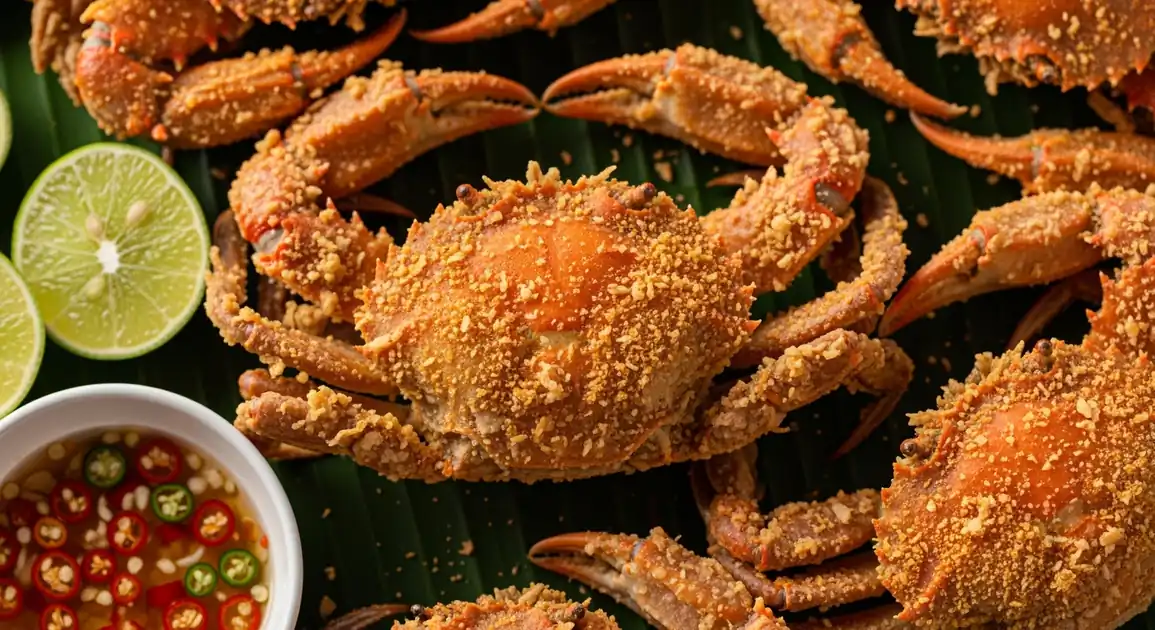Fried Soft Shell Crab
ปูนิ่มทอด (Poo Nim Tod)

Description
Fried soft shell crab is widely available throughout Thailand's coastal regions and major cities, reflecting the country's rich seafood culture. The dish exemplifies Thailand's expertise in selecting the freshest ingredients and applying simple cooking techniques that highlight natural flavors. From Bangkok's high-end restaurants to humble beachside stalls in the south, Poo Nim Tod appears in various forms, though the fundamental preparation remains consistent.
Dietary Information
Serving information
Serving style
Typically served on a plate or banana leaf, garnished with fried garlic, coriander leaves, and accompanied by lime wedges and seafood dipping sauce. Often part of a larger seafood meal shared among diners.
Quick facts
Most seafood vendors operate from late afternoon until late evening (4 PM - 10 PM), with peak hours being dinner time (6 PM - 9 PM).
Safety Tips
What to Look For
-
Crabs fried fresh upon ordering
Soft shell crab should be cooked to order, ensuring it's hot, fresh, and properly cooked throughout. This minimizes bacterial growth and ensures food safety.
-
Clean, hot oil with vigorous bubbling during frying
Proper frying temperature (around 180°C/350°F) kills potential pathogens and creates the ideal crispy texture. Oil should bubble actively when the crab is added.
-
Seafood displayed on clean ice or in aerated tanks
Before cooking, quality vendors store seafood properly chilled on ice or keep soft shell crabs alive in tanks, indicating freshness and proper handling.
-
Vendor using separate utensils for raw and cooked food
Good hygiene practices include using different tongs or spatulas for handling raw seafood and serving cooked items, preventing cross-contamination.
What to avoid
-
Pre-fried crabs sitting at room temperature
Avoid vendors who fry large batches in advance and let them sit. This allows bacterial growth and results in soggy, less tasty crab.
-
Strong fishy or ammonia smell
Fresh seafood has a mild, clean ocean scent. Strong fishy or ammonia odors indicate decomposition and potentially unsafe product.
-
Dark, smoking oil with debris floating in it
Old, repeatedly used oil darkens and creates harmful compounds. Good vendors change oil regularly and filter it between batches.
-
Visible dirt or unsanitary conditions at the stall
Overall cleanliness is a good indicator of food safety practices. Avoid vendors with dirty preparation surfaces, unclean hands, or generally poor hygiene.
Price information
Price range
Budget tips
- Street food vendors and local markets typically offer the best value, with prices around 150-250 THB per serving.
- Tourist areas charge premium prices; moving just a few streets away from main tourist drags can reduce prices by 30-40%.
- Seafood markets where you can select your own seafood often provide better value than restaurants.
- Consider sharing a larger portion as part of a group meal for better value.
Value indicators
- Generous crab size relative to price.
- Inclusion of quality dipping sauce and garnishes.
- Crabs fried fresh to order.
- Clean, non-greasy appearance.
- Served with complimentary rice or side dishes.
Where to Find This Dish
Coastal Areas
Beachfront restaurants and night markets in seaside towns offer some of the freshest options, often sourcing directly from local fishermen.
Beach promenades, Fishing piers, Seafood markets
Evening, Dinner
Night Markets
Urban night markets across Thailand feature seafood sections where soft shell crab is commonly found among other seafood options.
Food courts, Seafood zones
Evening, Night
Fresh Markets
Local fresh markets (Talad Sod) often have food stalls that prepare dishes from the market's seafood section.
Seafood sections, Cooked food areas
Morning, Afternoon
Vendor Tips
- Ask 'Poo tod sadai mai?' (Is the crab fried fresh to order?)
- Seafood specialists with tanks or iced displays typically offer fresher products than general food stalls.
- Vendors who can explain their sourcing or show uncooked product are typically more trustworthy.
How to Order
Regional Variations
-
Salt and Pepper Soft Shell Crab
(ปูนิ่มทอดพริกเกลือ (Poo Nim Tod Prik Glua))
Fried soft shell crab tossed with a fragrant mixture of salt, white pepper, chili, and fried garlic. This variation emphasizes a drier, more intensely seasoned exterior.
-
Curry Powder Soft Shell Crab
(ปูนิ่มทอดผงกะหรี่ (Poo Nim Tod Pong Karee))
Soft shell crab seasoned with yellow curry powder before frying, giving it a golden color and aromatic curry flavor. Often garnished with fried curry leaves.
-
Garlic Soft Shell Crab
(ปูนิ่มทอดกระเทียม (Poo Nim Tod Kratiem))
Topped with copious amounts of crispy fried garlic after frying. The strong garlic aroma and flavor complement the sweet crab meat.
-
Soft Shell Crab with Mango Salad
(ปูนิ่มทอดยำมะม่วง (Poo Nim Tod Yam Mamuang))
Fried soft shell crab served atop or alongside a spicy green mango salad, creating a delicious contrast of hot crispy crab with cool, tangy salad.
-
Chili Sauce Soft Shell Crab
(ปูนิ่มผัดพริกเผา (Poo Nim Pad Prik Pao))
After frying, the crab is briefly stir-fried with Thai roasted chili paste, creating a spicy-sweet glazed exterior. A more saucy variation popular in restaurants.
Cultural context
History
Soft shell crab has long been enjoyed in Thailand's coastal regions where mangrove mud crabs are abundant. While not originally a Thai dish (the preparation is found across Southeast Asia), Thailand has embraced it as part of its extensive seafood repertoire. In tourist destinations like Phuket, the dish has grown in popularity, becoming a must-try item at seafood markets and restaurants. The technique of harvesting crabs at the precise molting moment requires skill, making soft shell crabs relatively special compared to other seafood options.
Local significance
In Thailand, seafood represents prosperity and the rich bounty of the country's coastal waters. Soft shell crab is considered somewhat special compared to regular crab, as it's only available during specific molting periods and requires precise timing to harvest.
Eating customs
- Squeezing fresh lime over seafood before eating is common practice.
- The accompanying sauce is meant to complement, not overpower, the natural flavor of the crab.
- It's acceptable to eat with your hands, especially at casual establishments.